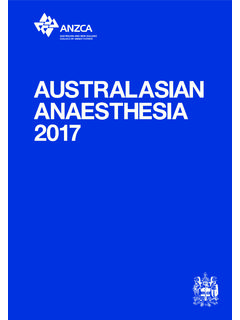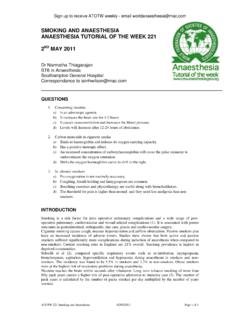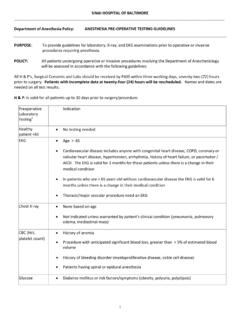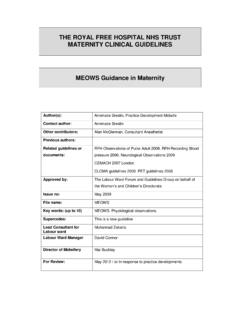Transcription of Patient Safety Solutions | volume 1, solution 7 | …
1 WHO Collaborating Centre for Patient Safety Solutions Aide Memoire Avoiding Catheter and Tubing Mis-Connections Patient Safety Solutions | volume 1, solution 7 | May 2007. Statement of Problem and Impact: Tubing, catheters, and syringes are a fundamental aspect of tient. Though these errors are highly preventable and can often daily health care provision for the delivery of medications and be easily averted, multiple reports of Patient injury and death fluids to patients . The design of these devices is such that it is from such wrong route medication errors indicate that they oc- possible to inadvertently connect the wrong syringes and tubing cur with relative frequency (1-7).
2 This includes erroneous ad- and then deliver medication or fluids through an unintended ministration routes for aerosols. and therefore wrong route. This is due to the multiple devices In the United States of America (USA), nine cases of tubing used for different routes of administration being able to connect misconnections involving seven adults and two infants have to each other. The best solution lies with introducing design fea- been reported to the Joint Commission's Sentinel Event data- tures that prevent misconnections and prompt the user to take base, resulting in eight deaths and one permanent loss of func- the correct action.
3 Tion (8). Similar incidents have been reported to other agen- Other causes or contributing factors include: cies, including the ECRI Institute, the United States Food and Drug Administration, the Institute for Safe Medication Practices Luer connectors. Used almost universally in a variety of (ISMP), and the United States Pharmacopeia (USP). Data from medical applications to link medical devices, including these groups reveal that misconnection errors occur with sig- fluid delivery (via the enteral, intravascular, spinal, and epidural routes) and insufflation of gas (in balloon cath- nificant frequency and, in a number of instances, lead to deadly eters, endotracheal cuffs, and automatic blood pressure consequences (9,10).)
4 Devices), they have been found to enable functionally The most common types of tubes and catheters involved in the dissimilar tubes or catheters to be connected. cases reported to the Joint Commission are central venous cath- Routine use of tubes or catheters for unintended pur- eters, peripheral IV catheters, nasogastric feeding tubes, per- poses. This includes using intravenous (IV) extension cutaneous enteric feeding tubes, peritoneal dialysis catheters, tubing for epidurals, irrigation, drains, and central lines tracheostomy cuff inflation tubes, and automatic blood pres- or to extend enteric feeding tubes.
5 Sure cuff insufflator tubes. Examples include specific miscon- nections involving an enteric tube feeding into an IV catheter Positioning of functionally dissimilar tubes used in pa- (four cases); a blood pressure insufflator tube connected to an tient care in close proximity to one another. For exam- IV catheter (two cases); and the injection of intravenous fluid ple, use of an enteral feeding tube near a central intra- venous catheter and tubing. into a tracheostomy cuff inflation tube (one case). In the United Kingdom, between 2001 and 2004, there were Movement of the Patient from one setting or service three reports of death, and from 1997 to 2004 there were four re- to another.
6 Ports of harm or near misses following wrong route errors when Staff fatigue associated with working consecutive shifts. oral liquid medicines, feeds, and flushes were administered in- Tubing and catheter misconnections can lead to wrong route travenously (11). A review of the National Reporting medication errors and result in serious injury or death to the pa- and Learning System in the United Kingdom identi- fied 32 reported incidents in which oral liquid medicines 2. Incorporate training on the hazards of misconnecting were administered by the intravenous route, seven incidents tubing and devices into the orientation and continuing in which epidural medication was administered via the professional development of practitioners and health- intravenous route, and six incidents in which intravenous care workers.
7 Medication was administered via the epidural route from 3. Promote the purchasing of tubes and catheters that are 1 January 2005 to 31 May 2006. designed to enhance Safety and to prevent misconnec- tions with other devices or tubes. Associated Issues: While various approaches to preventing catheter miscon- Looking Forward: nection and wrong route administration have been sug- 1. Physical barriers ( incompatibility by design). gested, meticulous attention to detail when administering medications and feedings ( the right route of administra- should be created to eliminate the possibility of inter- tion) and when connecting devices to patients ( using connectivity between functionally dissimilar medical the right connection/tubing) is a basic first step.
8 By imple- tubes and catheters to the extent feasible. menting preventive measures many of them simple and 2. Specific labeling of device ports is advocated to avoid inexpensive wrong route administration errors can be connecting intravenous tubing to catheter cuffs or effectively eliminated. balloons (3). 3. The use of different, dedicated infusion pumps for spe- Suggested Actions: cific applications such as epidural infusions has also The following strategies should be considered by WHO been proposed (12). Member States. 4. Using only oral/enteral syringes to administer oral/en- 1.
9 Ensure that health-care organizations have systems teral medications and avoiding the use of adapters and and procedures in place which: three-way taps are part of several draft proposals from Emphasize to non-clinical staff, patients , and fami- the United Kingdom's National Patient Safety Agency lies that devices should never be connected or to prevent wrong route errors (13). disconnected by them. Help should always be re- 5. A combined preventive strategy of performing risk as- quested from clinical staff. sessments to identify existing misconnection hazards, Require the labeling of high-risk catheters ( encouraging manufacturers to design dissimilar cath- arterial, epidural , intrathecal).
10 Use of catheters eters and tubes to be physically impossible to connect with injection ports for these applications is to ( incompatibility by design ), acquisition of equip- be avoided. ment whose design makes misconnections unlikely, Require that caregivers trace all lines from their and policy implementation to minimize misconnec- origin to the connection port to verify attachments tion occurrences has been advocated (14,15). before making any connections or reconnec- 6. The colour-coding of tubing and connections should tions, or administering medications, Solutions , or other products.

















